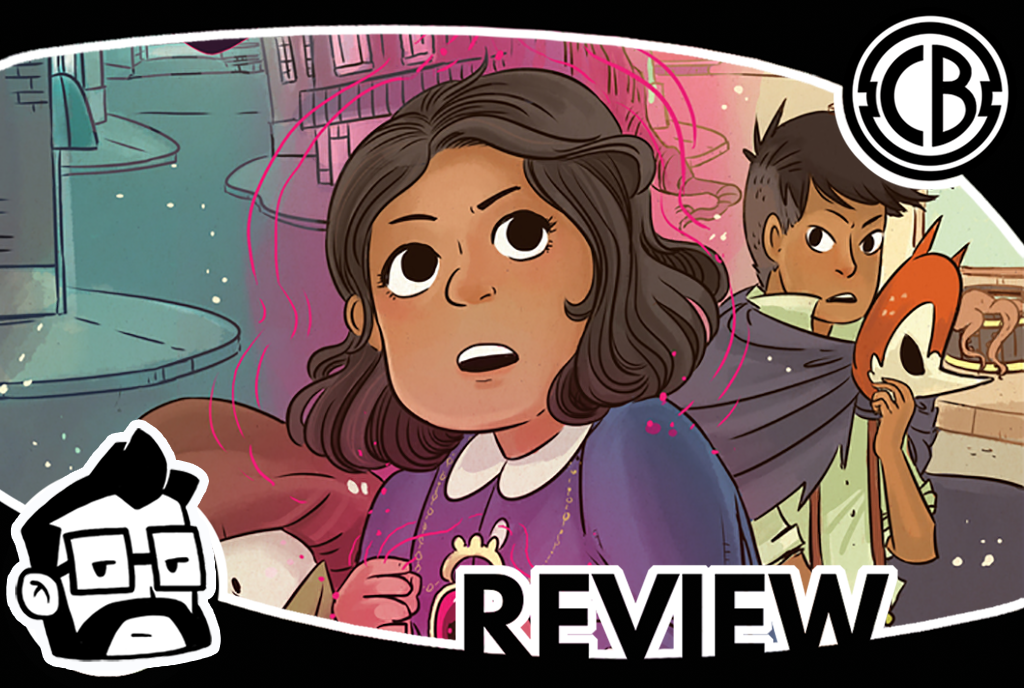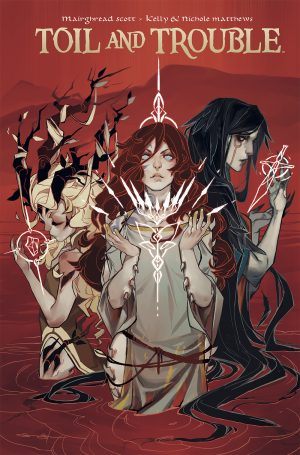On September 14th, BOOM! Studios will be releasing a hardcover edition of Toil and Trouble, one of the best mini-series of 2015-2016. Writer Mairghread Scott and artists Kelly and Nichole Matthews were kind enough to let me pick their brains. Check out the interview below.
LARAMIE MARTINEZ: Mairghread, the Witches are clearly the main focus of the series, but I noticed you also spend a considerable amount of time on Lady Macbeth and how the loss of her son shaped her perspective. Since there is some debate as to whether or not the play’s version of the character ever had a child, did you deliberately make a choice to have the loss of her child be crucial to the story? Or did you feel like you were expanding what was already in the source material?
MAIRGHREAD SCOTT: I think this is the perfect example of why I wrote Toil and Trouble. The Macbeths have no children in the play Macbeth, but a single line from Lady Macbeth clearly indicates she had one at one point (she mentions nursing a child, which would have been an extremely unlikely thing to do without having given birth). What happened to that child is never stated; its name, its life, how the Macbeths feel about it, none of these facts are said. But the fact that there was a child (who most probably died) changed everything for me.
Now this power-hungry, throat-cutting, “take what you want and screw everyone else” character was a woman who knew first-hand how easy it is for life to rob you blind. Her loss was not sentimental or maudlin; it was vicious, and she used it to justify vicious things.
It’s the exploration of these small details, the “why” behind the “what,” that is at the heart of Toil and Trouble. The witches, the Macbeths, everyone in our story is fighting to overcome things that happened years or even centuries ago. The ones that can do that rise, but the people that can’t become a threat to everyone around them.
LM: Mairghread, you’re an animation writer by trade, do you find a lot of crossover between writing animation scripts and comic scripts? What are some of the differences?
MS: I do find a lot of crossover between the animation I write and comics. Animation, in particular, is a very visually-oriented medium. Otherwise, why bother to pay to animate it? So you learn as an animation writer to focus on what we’re actually seeing and to break up your dialogue with fighting, movement, and impressive visuals that also push your story forward.
The difference between the two is pacing. While animation is about moving images, comics are about still images that suggest movement. They’re the haiku of animation writing. And there’s a big difference between writing a two-page fight in an animation script and distilling a two-page fight down to six or seven images.
Thankfully, Toil and Trouble has an impressive art team like Kelly and Nichole Matthews to work with, though. In animation and in comics, no one actually gets to see very much of my work. It’s in the hands of fantastic artists like the Matthews sisters to turn my hyper-technical descriptions into something you’ll actually want to look at.
LM: Each of the witches feels very distinct in both personality and design. In the story, they also seem to function more like goddesses or the classical Fates. Mairghread, did you have a different mythological inspiration for each character? Or are they more of a hodgepodge from the different sea, air, and land figures from various cultures?
MS: I tried to draw on a lot of Celtic mythology and history to build each of the three witches. Design-wise, each one is tied to a different element/realm with Smertae being Water, Riata as Air, and Cait as Earth. (As a side note, ancient Celts were way more into the number 3 than 4 so fire as an “element” wasn’t nearly as important to them as it was in other faiths.)
The idea behind our witches is that each was made a sort of Fate-like demigod after sacrificing their lives for their communities. So they all reflect the history and culture of Scotland, but at different times. From Cait, whose people were suffering the effects of the last Ice Age, to Riata’s war against the advancing Roman army, you see really different cultures that still spring from the same physical area. And since none of them are from their “current” time, it makes all the witches strangers in their own homeland. It’s a major source of conflict in our book.
LM: There are a lot of people of color included in this telling of Macbeth. There is even a study question in the back of the hardcover edition devoted to their depiction in the book. Is their inclusion a comment on the current lack of diversity in comics or was it more of an exercise in rethinking how cultures interacted during the 11th century?
MS: The inclusion of people of color in our book was nothing more than our attempt to accurately portray the history of the time. And the study question is to point out one very stark fact: much of what you think the past was like—the day-to-day—is nonsense. It’s a trap I almost fell into when I first started researching this book. Fortunately, resources like the Tumblr MedievalPOC and more recent historical investigations drove me to question what I actually knew versus what I just assumed I knew, and I dug deeper into my research for Toil and Trouble. Here are some highlights from what I found:
The 11th century had extensive coastal training throughout Europe, the Mediterranean, and Africa. Since most of Scotland’s population (and most of this book) lives on or near the coast, you’d expect to see more diversity to reflect that. The famed Roman 9th Legion that “vanished” in Scotland (i.e. whose last documented point of agreed upon existence was in Scotland) came from Spain, which had extensive economic and social ties with Morocco, and stayed there for years. Since soldiers stationed any place that long tend to intermingle with the local population, you’d expect more ancestral diversity as well. Retesting has shown many Vikings were women, so the Norwegian Navy got a gender boost (and probably should have gotten more of one) in our initial battles. The evidence goes on and on.
Of course, I’m a writer, not a historian, but I’m not interested in pushing “political correctness”; I’m interested in pushing factual correctness. And I’d rather we went too far on the side of challenging bad historical stereotypes (like, everyone in pre-industrialized Scotland was white and had always been white) than to stay safely in their borders.
Preview of Toil and Trouble Hardcover
[su_carousel source="media: 140598,140599,140600,140601,140602,140603,140604,140605,140606,140607,140608,140609,140610" link="lightbox" width="360" height="540" responsive="no" items="1" pages="yes" autoplay="3000" speed="500"]
LM: Kelly and Nichole, on your website it says that you’re both self-taught. Who are some of your influences and how did you get into comics?
KELLY & NICHOLE MATTHEWS: We’ve been inspired by so many things! Arthur Rackham, JH Williams III, comics like ElfQuest and Sandman, and anime (anything by Studio Ghibli and Matoko Shinkai are highly recommended!). The fantastical, unconventional storytelling and panel design we found in those really spoke to us and showed us that comics could be more than just a four-panel layout in the Sunday Comics.
As for how we got into this line of work, creating comics was something we have done in our spare time for years since we were younger. It was mostly fan comics (which we still do), but it helped us keep improving.
In the professional sense, we haven’t been here all that long. A few years ago we did a cover for BOOM!’s The Bravest Warriors comic, and that was actually the only “pro” thing we did for a long time, not counting the occasional anthology we’d participate in. It was only two years ago that it really took off—we signed on with Slipshine, then Filthy Figments, and about a year after that that we were signed for Toil and Trouble. We’ve been very fortunate that the work has been very constant since, and there are always new projects coming up as soon as old ones are ending. We’re very excited to see where we will be in the future.
While not unheard of, artists who work as a unit are a rarity in comics. How do you two divide the work? What’s your process?
K&NM: We try to divide things up fairly so that neither of us is shouldering the bulk of the work. We both tackle the thumbnails together; one of us will take the first pass, then the other will go over them and check for pacing, dynamics, etc. Kelly pencils, inks, and letters everything, and Nichole flats, colors, and adds any final touches or edits that’s needed, like special effects.
LM: Follow up question. Did your styles develop alongside each other? Or were each of you doing your own thing and then decided to come together?
K&NM: We knew very early on that drawing comics was something we wanted to do for a living. It was around the 4th grade, I think, that we decided the best way would be to draw comics together (thereby doubling our output). At that point, Kelly was better at drawing then Nichole was, and Nichole liked painting her pieces more, so we naturally just fell into the pattern that we still follow now, where Kelly would draw everything and Nichole would color it.
LM: I read that a friend of Mairghread’s named Sarah Stone originally designed the witches. Kelly and Nichole, what was it like making the transition from the original designs to the page?
K&NM: Sarah is an amazing character designer, and it wasn’t hard at all to transform her designs into our own style. There was not a lot of editing we had to do to make them easier to draw.
LM: Whose idea was it to include the Where’s Waldo tribute? Are there any other Easter eggs readers should look out for?
K&NM: When we got to the big fight scene, I don’t think Mairghread or [our Editor] Whitney [Leopard] were actually expecting us to put in as much detail as we did! We drew quite a few Easter Eggs that got taken out (understandably) so that BOOM! wouldn’t get in trouble, but you can still find Obi-Wan, Ranma, Vikings, Conan the Barbarian, Link, and some recolored Marvel and LoTR cameos that snuck under the radar.
LM: Do any of you have anything new coming up that we should look out for?
MS: Yes. I’ve recently launched the ongoing series Transformers: Till All Are One with IDW. It’s a bit more tech heavy than magic heavy, but if you liked the tension and political maneuvering in Toil and Trouble, you should definitely check it out.
K&NM: We’re very excited to have so many comics coming out soon! Breaker is a supernatural werewolf mystery we worked on with Mariah Huehner that will come out on Stela (the mobile comics app) soon. We have a piece in the Jim Henson’s Labyrinth Artist Tribute book and another secret project we’re working on with BOOM!. Last but not least, we’re drawing a comic with Audrey Redpath for Hiveworks called Symbol, about a young hero taking up their late mentor’s cowl and another for Hiveworks’ sister site, Mary’s Monster, called Maskless, about a group of aspiring supers determined to join the League of Heroes (even though they’re really bad at it).


